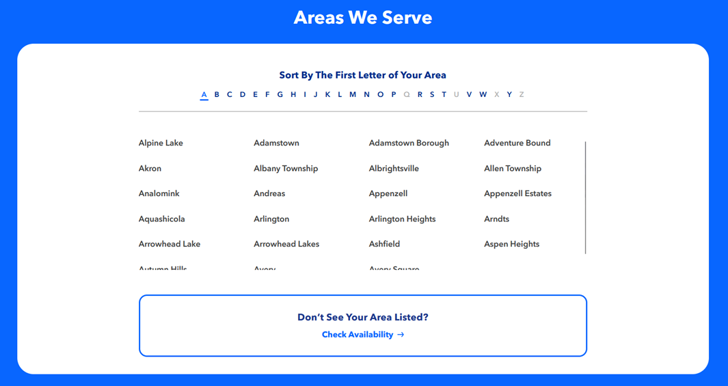Some of the biggest companies you know—Zapier, Airbnb, Canva—owe a large part of their marketing success to targeting long-tail, nonbranded keywords with well-executed collection pages.
These pages are the hidden drivers of organic growth. At Liquid, we’ve seen firsthand just how powerful they can be. They’ve helped our clients capture thousands of valuable searches that would otherwise slip through the cracks.
What Are Collection Pages
Collection pages are specialized landing pages that group products or services by a theme, attribute, or location. They go deeper than your standard “All Products” or “Services” page.
Think:
- “Black Bricks” instead of just “Bricks.”
- “Internet in [City]” instead of just “Internet Services.”
- “Best Hats for Summer” instead of just “Hats.”
They’re built to match the way people search. When someone types a detailed query, a well-structured collection page is often the best possible answer.
Why Do Collection Pages Matter
Collection pages hit the SEO sweet spot.
- Search visibility: They capture long-tail keywords your main pages can’t.
- User experience: Visitors land on exactly what they’re looking for, not a generic overview.
- Conversions: These pages attract people who already know what they want, which means higher intent and better results.
- Internal linking & authority: They act as hubs, strengthening your site architecture and signaling expertise to search engines.
And now, with AI-driven searches becoming longer and more specific, these pages feed machines (and people) the detailed information they’re hungry for. That’s a huge edge.
Collection Pages in Action: Liquid’s Client Work
Expanding Service Area Coverage for an Internet Service Provider
One of our clients, an ISP, had location pages for cities with retail centers, but that left a big gap. Their main “Internet” page couldn’t target all the smaller cities and towns in their service area. They needed a way to rank for searches like “home internet in [location]” everywhere they operated, not just where they had a storefront.
The solution: create hundreds of /service-area pages, each dedicated to one location.
A common issue with creating collection pages at this scale is implementing an internal linking strategy that doesn’t seem spammy. We solved it by building an “Areas We Serve” component that could be featured on the main /locations page and all service area pages. Visitors can browse all service areas alphabetically, and if their area isn’t listed, there’s a clear CTA to check availability.

We also protected against duplicate content by varying FAQs, verbiage, and a couple of the page sections/components based on their relevance to the service area. The result was a scalable, crawlable system that opened the door to ranking in every city and township they cover.
Truly Unique Location Pages for Brickworks Supply Center
When Liquid took on this project, Brickworks already had dedicated pages for each of their Supply Centers, however, they all featured the exact same content. This is another one of the most common hurdtles of creating effective collection pages.
Search engines love unique content; we need to convince them that each page brings unique value to the user and therefore deserves to rank for its target keywords.
Our solution was simple, but highly effective:, a Google form for general managers. They filled it out with local insights like—most popular products, community involvement, nearby landmarks, etc. We used those responses to automatically generate content for each page, keeping them unique, authentic, and genuinely useful.

This simple process turned a potential duplicate -content problem into a strength. Each page fit into a clean, scalable system and now included keywords that were more likely to be searched by customers in each area since they were often naturally included in the responses.
Brick Color Pages That Dominate Search for Glen-Gery
Glen-Gery’s site already had faceted navigation for brick colors, but those filter pages weren’t SEO-friendly. Sure, we could add canonical links back to static URLs that list all of the products in that category with a generic paragraph of content… but that’s what all of our competitors were already doing.
Meanwhile, our potential customers were searching for bricks based on features like color and texture in huge numbers.
The solution? We built dedicated brick color pages, each packed with content:
- The most popular products of that color.
- Real project examples.
- Links to even deeper collections, like Black Glazed Brick.
- Internal links from case studies and blog posts mentioning those colors.

The results were immediate:. Nearly all the color pages now rank in the top three for their keywords, driving significant traffic. Even niche colors that only attract dozens of searches add up when combined.
Together, these pages deliver massive, ongoing SEO value and are among the most important on the site for driving relevant organic traffic.
Lessons Learned
From these projects, a few best practices stand out:
- Build collection pages on real search demand—let keyword data guide you.
- Make each page unique with useful content—don’t just swap out a city name or color.
- Use smart navigation to make pages easy to find and crawl.
- Leverage internal linking to strengthen topical authority.
- Scale carefully, but don’t lose the human touch.
Why This Strategy Matters Going Into 2026
The way people search is evolving. Queries are longer, more specific, and more natural. They are typed into Google, weaved into conversations with chat bots, and spoken to AI assistants. Collection pages are built for exactly these cases.
Most competitors aren’t implementing these well or at all. That means there is plenty of traffic waiting to be captured.
Your Next Growth Engine
Collection pages may not make headlines like a viral campaign, but they quietly drive some of the most impactful SEO results possible.
We’ve seen it at Liquid across industries: more visibility, more engagement, more conversions. When done right, they become one of the most valuable assets on your site.
If you’re ready to unlock that potential, let’s talk. We’d love to help you build collection pages that put your business in front of the customers already searching for you.


